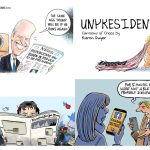Editorial Cartoons and the Power of Visual Metaphors: Editorial cartoons have long been a potent tool for social and political commentary. Their ability to distill complex issues into a single, impactful image makes them a unique and powerful form of communication. At the heart of their strength lies the art of visual metaphors – a language that transcends linguistic barriers, allowing cartoonists to convey profound messages with a stroke of the pen. In this exploration, we will delve into editorial cartoons, examining their historical significance, the role of visual metaphors, and the impact of some of the most renowned cartoonists.

The Historical Significance of Editorial Cartoons:
Editorial cartoons have a rich history dating back to the 18th century. Notable figures like James Gillray and George Cruikshank used their artistic talents to satirize and comment on their time’s political and social issues. As print media flourished, editorial cartoons became a staple in newspapers, providing a visual commentary that resonated with a broad audience.
In the 20th century, cartoonists like Herblock (Herbert Block) and David Levine gained prominence for their incisive depictions of political figures. Herblock’s cartoons, particularly during the Watergate scandal, were crucial in shaping public opinion and holding those in power accountable. Editorial cartoons have continued to evolve, adapting to new mediums and reaching audiences through digital platforms.

The Power of Visual Metaphors:
At the core of editorial cartoons lies the power of visual metaphors. Unlike written or spoken language, visual metaphors can transcend cultural and linguistic barriers, making them a universal form of communication. Cartoonists use symbols, caricatures, and analogies to distill complex ideas into accessible and often humorous images.
A. Symbols and Caricatures:
Symbols play a pivotal role in editorial cartoons. Cartoonists employ symbols to represent complex ideas or entities in a simple and recognizable form. For instance, a donkey and an elephant are widely recognized symbols for the Democratic and Republican parties in the United States. These symbols and caricatures of political figures serve as visual shorthand, allowing cartoonists to convey complex political scenarios easily.
B. Analogies and Allegories:
Cartoonists often draw on analogies and allegories to convey their messages. Drawing parallels between unrelated concepts can shed light on the absurdity or irony of a situation. For example, during economic crises, cartoonists may depict the economy as a sinking ship or a house of cards on the verge of collapse. Visual metaphors simplify complex issues and evoke emotional responses, making the message more memorable.

Impactful Editorial Cartoonists:
A. Herblock (Herbert Block):
Herblock, the legendary editorial cartoonist for The Washington Post, earned acclaim for his unflinching criticism of political corruption and abuse of power. His cartoons played a significant role in exposing and challenging the actions of Senator Joseph McCarthy during the Red Scare. They later contributed to the public’s understanding of the Watergate scandal. Herblock’s ability to distill complex issues into powerful images cemented his legacy as a trailblazer in editorial cartoons.
B. Michael Ramirez:
A two-time Pulitzer Prize-winning cartoonist, Michael Ramirez is known for his sharp wit and insightful commentary. Working for various publications, including Investors Business Daily and the Los Angeles Times, Ramirez uses visual metaphors to comment on various issues, from politics to economics. His ability to distill intricate topics into clever and visually striking cartoons has made him a prominent figure in contemporary editorial cartooning.
C. Ann Telnaes:
As the first female editorial cartoonist to win the Pulitzer Prize, Ann Telnaes has left an indelible mark on the field. Her work, characterized by its boldness and fearlessness, addresses many social and political issues. Telnaes utilizes visual metaphors to challenge societal norms and highlight systemic injustices, contributing to the ongoing conversation about gender, race, and power dynamics.

The Evolution of Editorial Cartoons in the Digital Age:
In the age of social media and instant communication, editorial cartoons have found new life on digital platforms. Cartoonists can now reach global audiences instantaneously, amplifying the impact of their visual metaphors. Social media platforms serve as a democratizing force, allowing emerging cartoonists to gain recognition and contribute to public discourse.
A. Memes and Virality:
The rise of memes has introduced a new dimension to editorial cartoons. Memes, often rooted in visual metaphors, spread rapidly through online communities, reaching audiences beyond traditional media channels. Cartoonists who can create visually impactful and shareable content can potentially influence public opinion on a massive scale.
B. Interactive Cartoons:
Some cartoonists have embraced interactivity in the digital realm, creating animated or clickable cartoons that further explore complex issues. This innovative approach allows audiences to engage with the content on a more immersive level, fostering a greater understanding of the underlying message.

Conclusion:
Editorial cartoons, relying on visual metaphors, are a dynamic and influential form of communication. From their historical roots to their contemporary presence on digital platforms, these cartoons have the power to shape public opinion, challenge authority, and distill complex issues into accessible images. The legacy of editorial cartoonists like Herblock, Michael Ramirez, and Ann Telnaes is a testament to the enduring impact of visual metaphors in social and political commentary. As we navigate the complexities of the modern world, editorial cartoons remain vital for sparking conversation, inspiring change, and holding those in power accountable.
Read also: The Art of Caricature in Editorial Cartoons: A Humorous Lens on Society and The Global Reach of Political Editorial Cartoons: Satire Beyond Borders
Frequently Asked Questions about Editorial Cartoons and the Power of Visual Metaphors
What is an editorial cartoon?
An editorial cartoon is a form of visual commentary that uses images and humor to convey political, social, or cultural opinions. Often published in newspapers or online, these cartoons distill complex topics into accessible and impactful visual metaphors.
What is the purpose of editorial cartoons?
Editorial cartoons provide commentary, criticism, or satire on current events, political figures, and societal issues. They aim to communicate a message, evoke emotions, and prompt reflection through visual metaphors.
How do visual metaphors work in editorial cartoons?
Visual metaphors in editorial cartoons involve symbols, caricatures, analogies, and allegories to visually represent complex ideas or situations. These metaphors simplify and distill intricate issues, making them more understandable and memorable to a broad audience.
Why are symbols and caricatures commonly used in editorial cartoons?
Symbols and caricatures serve as visual shorthand in editorial cartoons. Symbols, like the donkey and elephant in American politics, represent political parties, while caricatures exaggerate distinctive features of individuals, making them instantly recognizable and adding humor to the commentary.
Who are some famous editorial cartoonists known for their use of visual metaphors?
Notable editorial cartoonists include Herblock (Herbert Block), known for his work during the Watergate scandal; Michael Ramirez, a two-time Pulitzer Prize winner for his insightful commentary; and Ann Telnaes, the first female editorial cartoonist to win a Pulitzer Prize, recognized for her fearless approach.
How have editorial cartoons evolved in the digital age?
In the digital age, editorial cartoons have gained a broader audience through social media platforms. The rise of memes and virality has added a new dimension to their impact, allowing cartoonists to reach global audiences rapidly. Some cartoonists also create interactive content, enhancing engagement and understanding.
Can editorial cartoons influence public opinion?
Yes, editorial cartoons can influence public opinion by providing a unique perspective on current events. Combining visual metaphors, humor, and satire can make complex issues more relatable, prompting audiences to reflect on and reconsider their views.
Editorial cartoons contribute to discourse by visual commentary on societal and political issues. They serve as a form of critique, prompting conversations, challenging authority, and holding those in power accountable. The accessibility of visual metaphors makes these cartoons an effective medium for fostering dialogue.
Are there risks associated with the misinterpretation of editorial cartoons?
Yes, there is a risk of misinterpretation, as humor and symbolism can be subjective. Cartoonists must balance the use of visual metaphors to ensure their intended message is clear. Misinterpretation may lead to confusion or unintended consequences, emphasizing the importance of thoughtful and responsible cartooning.
How can aspiring cartoonists get started in creating editorial cartoons?
Aspiring cartoonists can start by studying the work of established cartoonists, understanding current events, and practicing their artistic skills. Utilizing social media platforms for sharing their work and receiving feedback can help them build an audience and contribute to the ongoing conversation through the power of visual metaphors.
This post was created with our nice and easy submission form. Create your post!




